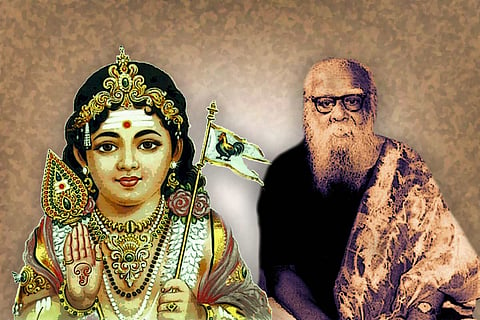

On July 26, the Chennai police invoked the Goondas act against Surendran, the founder of YouTube channel Karuppar Kootam and his colleague SJ Gopal of the Hindu Tamil Peravai. They were both arrested for circulating content alleged to be defamatory on the Kanda Sashti Kavasam, a Hindu prayer, on social media.
Three days later, the Coimbatore police detained a Bharat Sena functionary, M Arun Krishnan, for desecrating social reformer Periyar EV Ramasamy's statue. This man was booked under the stringent National Security Act (NSA), hardly invoked for acts of desecration.
The preventive detention acts were used on accused who represent two different spectrums of political ideologies currently battling it out in Tamil Nadu. But the manner in which the government has handled both these cases is similar point out political experts. And this, they allege, clearly highlights the AIADMK's efforts to pull off a 'balancing act' ahead of the elections.
"The Hindutva tag is very dangerous in Tamil Nadu and the AIADMK cannot afford to be branded as such, before an assembly election," says M Bharath, a political analyst. "The party has always taken a cat on the wall approach when it comes to dabbling in Dravidian ideology and spiritualism. While it has been born out of leaders like Annadurai who preached rationalism, its leaders, be it former Chief Minister MG Ramachandran or J Jayalalithaa, have been deeply spiritual," he adds.
Bharathi points out that ahead of the state assembly elections in 2021, the government is being doubly cautious in avoiding any further branding, in order to maintain its vote bank.
"They saw what allying with the BJP could do to their vote bank in the Lok Sabha elections and the coming elections too will be a battle of spiritual politics against dravidian and Periyarist ideologies," says Bharath.
"The right wing has a soft corner for AIADMK, and at the same time their Dravidian roots make them acceptable to rationalist vote banks as well. By treating both these cases similarly, they are giving a clear message that they are a neutral party irrespective of past alliances. They will condemn the insult to Hindu prayers and vehemently oppose desecration of Periyar statues in order to strike a balance," he adds.
But legal experts point out that in an effort to maintain its vote bank, the government is blatantly violating and manipulating the law to suit its motives.
Preventive detention in its essence is the imprisonment of a person with aim of preventing them from committing further offences or of maintaining public order. Both the Goondas act and NSA act aims at a year long preventive detention of habitual offenders.
"So, ideally to book someone under the Goondas act, they need to have a history of having committed crimes," says advocate Akhila of the Madras High court. "And if this is their first crime then their act needs to have been created or lead to potential public disorder. Both these cases - the one against Karuppar Kootam and the man who desecrated the statue may legally allow for preventive detention, but it is completely against our democratic principles," she adds.
Then why are these Acts so readily invoked?
"Police use the preventive detention laws as a tool to bypass the regular criminal justice system. This way you don't have to hold a trial till the end of the year, the charges won't be public and the FIR document will not create public debate. It is an effective way of pushing an unfavourable situation under the carpet," she explains. "In a regular case, police would need evidence and the trial process is cumbersome. There are checks and balances and the accused has their own rights. But here they can simply silence them," she adds.
Advocate and political analyst 'Tharasu' Shyam, points out that the government looks at two aspects before they decide what action is required.
"The first is whether there is uproar over the particular issue from the public and the second is if it is a direct attack on symbology pertaining to their politics. Both these causes fit into one of these criterion," he says.
Senior advocate Kannadasan however alleges that the balance portrayed in justice in these cases is merely an eyewash.
"At first glance it may look like both these cases have been treated the same way and both accused have met with the same fate. But that is not the case," says advocate Kannadasan.
He explains that the Goondas Act and NSA have one fundamental difference. The Goondas act is a state act and therefore it is the state which will recommend whether it is applicable in a certain case or not. The NSA however, though invoked by the state, is actually a central act.
"So this means that the Centre decides whether the desecration of the Periyar statue is worth preventive detention. The accused in this case can send a representation in one week. An advisory board will be formed within 40 days after this to decide on the act, " says the advocate.
'Tharasu' Shyam explains that for the Goondas Act to be lifted, the process could be months long as opposed to bail on a regular case that can be reviewed every 14 days.
"It will take the state government 2.5 months to form the board. Then formalities that the accused have to complete will take a month. This in itself will mean atleast three months in prison," he says. "If they have to go to court, the accused's counsel will have to file a habeas corpus petition and this will get delayed in front of the division bench since the state has to respond. Either way, the accused have to face months of imprisonment before they get a chance to apply for bail."